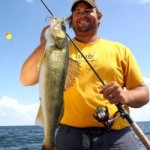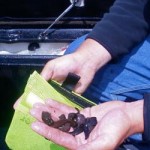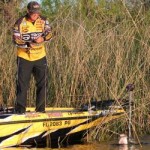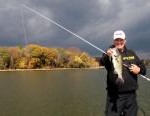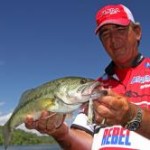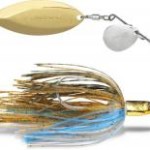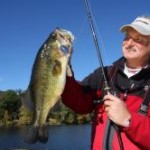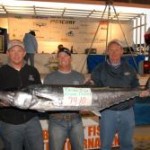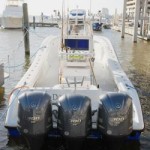Slab Time In The Peach State
Catching Spring Crappie In Georgia
If you have missed out on the ritual of catching crappie in Georgia in the spring you have missed one of the most enjoyable fishing experiences our state offers. The action is fast, the fish taste great and thousands of your fellow anglers take advantage of some of the best fishing Georgia has to offer.
Growing up near Clarks Hill I experienced the excitement each spring. Word would spread around McDuffie County like pine pollen blowing in the April wind – “The crappie are in the bushes.” Everyone from farmers who got in a boat once a year to bass fishermen who concentrated on largemouth 50 weeks a year to mommas and young kids would head to the lake to catch a mess of crappie.
This was the time to fill your freezer for fish fries that would last for months. For a two to three week period every cove at the lake would have several boats full of fishermen easing round the bank dropping minnows or jigs beside button bushes and pulling out shinning crappie. Everyone had a big smile on their face.
In lakes all over Georgia crappie go through their spawning cycle and fishermen show up to catch them. With a little effort you can expand the two week spawn when they are shallow into a full spring of catching fish. And you can do it on almost any public lake near you.
During the winter crappie are suspended out over big water, usually around some kind of wood. They hold over brush piles and tree tops and you can catch them but the weather is not very much fun and they are hard to find. Trolling and jigging is the most effective way to catch them.
As the water starts to warm in late February and early March the fish start to move toward the spawning areas. Depending on how fast it warms up, some crappie may be back in the spawning areas in late February but by mid to late March you can count on some laying eggs. Late March and early April is usually the prime time to catch them shallow.
Usually by mid to late April the shallow action is gone and the fish are heading back to deeper water. As they work out you can troll for them or shoot docks on lakes with lots of them. You can hit them in blowdowns on deeper banks toward the main lake. Then by early summer it is back to trolling and jigging in deeper water.
Spring is the time bank fishermen catch their share of crappie, too. From late February to late April the crappie are more likely to be near the bank and in reach of fishermen without boats. Find access at boat ramps, parks, fishing piers and roads that run near the water. Stay on public land and you can catch them.
If fishing from the bank it is a good idea to have several rods and poles so you can cover a fairly wide area. Keep some baits in near the bank but make long casts with others. When you catch one fish put all your bait in that spot because a school of crappie is probably moving through the area.
One exciting way to catch crappie on all our lakes is to tie up under a bridge or beside a treetop in deep water, hang a lantern over the side or drop a light into the water and wait for the shad to come to the light. Crappie will follow them and you can again load your boat. Many bridges look like small cities this time of year as dozens of boats light them up.
You can catch crappie all around Georgia but some lakes are better than others. Clarks Hill seems to always be good as are most bigger lakes. But don’t forget the smaller public waters like Public Fishing Areas and State Parks. If you live near one you know how good the fishing can be.
The following six lakes should all be good for crappie this spring. Choose one near you, hook up the boat if you have one, grab some poles and enjoy this ritual of spring.
Lake Allatoona
Although not known as a crappie hot spot, Allatoona has a good population of crappie and many anglers take advantage of it. Early spring fishing is good and there is less of the famed pleasure boat traffic on Allatoona. You can fish in relative peace.
The crappie fishing at Allatoona has been consistent for several years, according to the Georgia Department of Natural Resources, Wildlife Resources Division. (WRD) The crappie you catch should average about one-half pound and be just over eight inches long. Some crappie weighing a pound are better should be in your catch, too.
There is very little shoreline cover like bushes to fish unless the water is very high, so look for shallow crappie around blowdowns and brush piles put out by fishermen. There are also some docks to fish in the creeks.
Troll the creeks for them in the early spring then drop a jig or minnow beside any kind of wood cover when they are spawning.
Look for crappie back in Kellogg, Illinois and Stamp Creek. The DNR says these are all good places for crappie. You are likely to catch some of the biggest crappie of the year while the females are full of eggs and back in the spawning areas in the early spring.
As the water warms follow the crappie back out by trolling toward the mouths of the creeks. By early summer they will be schooled up on state brush piles and other cover put out by anglers on drops and humps on the main lake. Fishing for them at night will help you avoid most of the boat traffic and gives you the best chance of catching them.
Lake Harding
Lake Harding, also known as Bartletts Ferry, has a good population of big crappie. According to the DNR at least half the crappie in the lake are in the 10 to 14 inch range and will weigh about one-half to three-fourths of a pound. There are many larger fish that you can catch, too.
In late February crappie start moving into the many pockets and small creeks on the lake. Almost all these creeks and pockets have docks in them and many have brush piles around them. Crappie will move following the deeper water and you can catch them by trolling jigs. Then they will hold on the shallow dock posts and brush piles to spawn and this is a good time to shoot jigs under the docks and dabble jigs and minnows around the shallow cover.
Also look for the cypress trees planted by the WRD and Georgia Power on shallow areas on the main lake. The root balls of these trees often hold spawning crappie. Fish all around them with jigs and minnows, just like fishing shallow brush in the creeks.
As the crappie start to move out they will hold on deeper docks. Late spring is a good time to shoot jigs back under the docks into the shady areas where they are feeding. Try to get all the way back under docks to the heaviest shade on bright, sunny days. Respect dock owners and skip docks where they are fishing, there will be plenty of empty docks to fish.
There are six fish attractors put out by the WRD that offer excellent fishing as summer approaches. Drop minnows and jigs around them during the day or anchor and fish over them at night with a light. You can do the same kind of fishing in the river by tying up to treetops and logs in deeper water.
Lake Blackshear
When you first see Lake Blackshear you can’t help but think it is crappie heaven. And it is. The acres of cypress trees standing in shallow water, numerous docks and bridges all look like crappie hot spots and they are. Add to those places the 10 brush piles put out by the WRD and you can find crappie all over the lake.
According to the WRD you will catch both black and white crappie on Blackshear and the populations of both is fair. Most of the fish are under 10 inches long but there are a good many pound to pound-and-a-half fish to be caught. Early spring is the best time to get the bigger fish.
Blackshear is far enough south that many are spawning by late February. Look for them in the cypress tree root balls and around the docks in Collins Branch, Spring Creek, Gum Creek and Boy Scout Slough. Up the river all the backouts have good spawning areas as do many of the main river runs.
Drop jigs and minnows beside cypress tress but remember the root ball may extend out several feet. Fish from right beside the trunk out at least three feet from it. A minnow swimming around just over the root ball should be hit, and you can drop jigs down to the same areas.
By late March there are still good populations of crappie holding around docks but you can also catch them off the state brush piles or around the bridges. Fish both areas day or night from late March on through the summer.
Also troll creek channel ledges for them. Take lots of bug spray.
Lake Sinclair
Probably our most popular crappie fishing lake in the winter because of the warm water released from the Georgia Power steam plant, Sinclair is a good bet all spring long, too. Year after year it produces good catches of crappie and that should continue this year.
There are some two-pound plus crappie caught each year at Sinclair and most are over eight inches long. About a third of the crappie at Sinclair are 10 inches long or longer and will weigh over half a pound. In the spring they will be fat and heavy.
You can start trolling for crappie and catching them early at Sinclair if you concentrate on water warmed by the outflow in Beaverdam Creek. By early March many crappie will be found in the backs of coves looking for spawning areas around docks, brush and bushes. The area from Beaverdam Creek to the dam will see fish move in earlier with those up the Little River and Oconee River arms moving in shallow a little later.
Check out Rooty Creek for good spawning areas all during the spring. The lower creek is warmed by Beaverdam some when pumpback is running at Oconee and the upper end warms a little later. Drop minnows and jigs around dock posts and brush back in the creeks. The back one third should be best early when the fish are spawning.
When the water hits the mid 60s the fish are mostly finished spawning and moving back out. Start shooting docks in the coves, concentrating on the docks in the outer two-thirds of the creek. When you catch a crappie around a dock stay there, there should be others as they school up this time of year.
There are several good state brush piles to fish in late spring and the main lake docks hold crappie, too. Troll the open water around the brush piles or shoot jigs to deeper docks in late spring to find the fish. Many crappie are also caught under the Little River bridge from late spring to summer.
Hamburg Lake
One of the most peaceful places to catch crappie may also be the best to catch big crappie. Hamburg is a 225 acre lake located in Hamburg State Park just north of Sandersville. Motors are limited to 10 horsepower so the lake stays quiet and calm. You can camp there and boat rental is also available.
Although crappie you catch at Hamburg will average about a half-pound, there are a good many two-pound-plus fish in the lake. The lake is full of stumps and crappie love wood cover, so you can usually locate them fairly easily.
In the early spring look for stump beds and brush out from the bank and either troll carefully through the area or cast jigs to them. As the water warms cast jigs to all the shoreline cover or dabble minnows in it. In late spring troll the old river channel and fish the standing timber along it with jigs and minnows.
When fishing standing timber, try to find the depth the crappie are holding by spotting them on a depthfinder. If you can’t see the fish for the forest, drop a live minnow or jig down and work it deeper and deeper until you catch a crappie. When you catch one note the depth and concentrate on it, that is the depth most of the crappie should be holding.
Lake Hartwell
Hartwell is a big lake with lots of arms and they all offer good crappie fishing. Different parts of the lake warm at different rates so you can usually find a variety of types of fishing at the same time. You can pick one area to fish and follow them as they move in or try to hit spawning crappie over different areas and extend that catch.
There was an excellent crappie spawn a few years ago after the water was down and that year class is getting bigger every year. They should be around 10 to 12 inches long this year and weigh about three-fourths of a pound. There are bigger crappie in the lake but for a good average size Hartwell should be excellent this year.
Start looking for crappie over structure like roadbeds and standing timber near the mouths of coves and creeks in early March. As the water warms follow the schools back into the creeks and coves, trolling for them. Watch for schools of baitfish as well as the crappie as you troll. They will often follow the shad as them move in, too.
By early April the crappie should be back in the coves spawning around bushes and other cover. Check out Eastanollee, Gum Log and Shoal Creek for better chances at crappie since those creeks have more color to the water and you can catch more there. If the water is too clear it is hard to get them to bite if they are real shallow, and the stained water is more fertile and supports more fish.
Late in the spring follow the fish back out trolling the creek channels and over standing timber. Night fishing is excellent in the clear water under bridges and over the standing timber. Use a bright light and fish your favorite jig or live minnow. Try different depths until the fish start hitting and tell you where they are holding if you don’t see them on your depthfinder.
All of these lakes offer great crappie fishing this spring. Pick one near you or head out to find new waters. Don’t miss one of the best times of the year to catch crappie.
